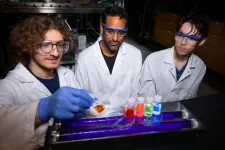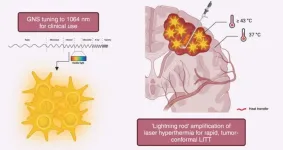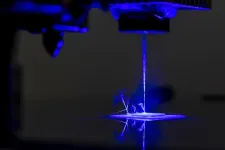(Press-News.org) Researchers at the University of Toronto have harnessed a bacterial immune defense system, known as CRISPR, to efficiently and precisely control the process of RNA splicing.
The technology opens the door to new applications, including systematically interrogating the functions of parts of genes and correcting splicing deficiencies that underlie numerous diseases and disorders.
“Almost all human genes produce RNA transcripts that undergo the process of splicing, whereby coding segments, called exons, are joined together and non-coding segments, called introns, are removed and typically degraded,” said Jack Daiyang Li, first author on the study and PhD student of molecular genetics, working in the labs of Benjamin Blencowe and Mikko Taipale at U of T’s Donnelly Centre for Cellular and Biomolecular Research.
Exons can be alternatively spliced, such that the regulation and function of the approximately 20,000 human genes that encode proteins are greatly diversified, allowing the development and functional specialization of different types of cells.
However, it is unclear what most exons or introns do, and the mis-regulation of normal alternative splicing patterns is a frequent cause or contributing factor to various diseases, such as cancers and brain disorders. However, existing methods that allow for the precise and efficient manipulation of splicing have been lacking.
In the new research study, a catalytically-deactivated version of an RNA targeting CRISPR protein, referred to as dCasRx, was joined to more than 300 splicing factors to discover a fusion protein, dCasRx-RBM25. This protein is capable of activating or repressing alternative exons in an efficient and targeted manner.
“Our new effector protein activated alternative splicing of around 90 percent of tested target exons,” said Li. “Importantly, it is capable of simultaneously activating and repressing different exons to examine their combined functions.”
This multi-level manipulation will facilitate the experimental testing of functional interactions between alternatively spliced variants from genes to determine their combined roles in critical developmental and disease processes.
“Our new tool makes possible a broad range of applications, from studying gene function and regulation, to potentially correcting splicing defects in human disorders and diseases”, said Blencowe, principal investigator on the study, Canada Research Chair in RNA Biology and Genomics, Banbury Chair in Medical Research and professor of molecular genetics at the Donnelly Centre and the Temerty Faculty of Medicine.
“We have developed a versatile engineered splicing factor that outperforms other available tools in the targeted control of alternative exons,” said Taipale, also principal investigator on the study, Canada Research Chair in Functional Proteomics and Proteostasis, Anne and Max Tanenbaum Chair in Molecular Medicine and associate professor of molecular genetics at the Donnelly Centre and Temerty Medicine. “It is also important to note that target exons are perturbed with remarkably high specificity by this splicing factor, which alleviates concerns about possible off-target effects.”
The researchers now have a tool in hand to systematically screen alternative exons to determine their roles in cell survival, cell type specification and gene expression.
When it comes to the clinic, the splicing tool has potential to be used to treat numerous human disorders and diseases, such as autism and cancers, in which splicing is often disrupted.
This research was supported by the Canadian Institutes of Health Research and the Simons Foundation.
END
U of T researchers develop RNA-targeting technology for precisely manipulating parts of human genes
2024-06-24
ELSE PRESS RELEASES FROM THIS DATE:
NexusXp™ – SLAS’s new interactive pavilion at SLAS2025 will showcase automation integration and collaboration
2024-06-24
Oak Brook, IL – The Society for Laboratory Automation and Screening (SLAS) will launch NexusXp, its new interactive pavilion at SLAS2025 to showcase collaborative and integrated lab automation scenarios. NexusXp combines Nexus, the Latin word for link or connection where multiple elements meet, with the modern “Xp” to signify the “Xperience” of making that critical link or connection. Through this new pavilion, SLAS will demonstrate how automation integration transforms research and enables scientific breakthroughs.
“NexusXp is an exclusive event or attendee ...
Engineers developing atom-thick material for efficient, ultrafast, light-based electronics
2024-06-24
AMES, Iowa – A Google Cloud video takes you inside a company data center in
southwest Iowa’s Council Bluffs.
There you are, in the middle of a long, industrial corridor. You slowly move past rack after rack after rack of the computer servers that are, Google says, “helping to keep the internet humming 24/7.”
Part of that hum is the power that keeps those data centers up and running.
“Think about when you use your computer,” said Matthew ...
Study reveals same genes that can drive cancer also guide neural-circuit growth
2024-06-24
LAWRENCE — Many people are familiar with oncogenes — genes long known to be involved in cancers in humans, such as the gene “Src.”
What’s less widely understood is that oncogenes didn’t evolve just to cause cancer in species, but rather to control events of normal growth and differentiation.
“As an organism grows from a single fertilized egg to form all the different tissue types, these oncogenes, including Src, evolved to control these normal events,” said Erik Lundquist, professor of molecular ...
Leveraging gold nanostars for precision laser interstitial thermal therapy
2024-06-24
“Gold nanostars amplify brain-tumor selective laser interstitial thermal therapy.”
BUFFALO, NY- June 24, 2024 – A new editorial paper was published in Oncotarget's Volume 15 on June 14, 2024, entitled, “Leveraging gold nanostars for precision laser interstitial thermal therapy.”
In this new editorial, researchers Aden P. Haskell-Mendoza, Ethan S. Srinivasan, Tuan Vo-Dinh and Peter E. Fecci from Duke University discuss laser interstitial thermal therapy (LITT). Over the past decade, LITT has become an important tool for the neurosurgical treatment of a variety of intracranial pathologies, including focal epilepsies, vascular malformations, and ...
Biodiversity loss from 2010 oil spill worse than predicted
2024-06-24
A new peer-reviewed study from researchers at The University of Texas at Arlington; the University of Nevada, Reno; Mokwon University in Daejeon, Korea; and Texas A&M University at Corpus Christi shows the Deepwater Horizon (DWH) oil spill of 2010 affected wildlife and their habitat much more than previously understood.
“Overall, we found the area of deep-sea floor affected by the DWH spill was significantly larger than previously thought,” said Masoud Rostami, an author of the study and assistant ...
New model shows more realistic picture of intimate partner violence
2024-06-24
ITHACA, N.Y. – Intimate partner violence is notoriously underreported and correctly diagnosed at hospitals only around a quarter of the time, but a new method provides a more realistic picture of who is most affected, even when cases go unrecorded.
PURPLE (Positive Unlabeled Relative PrevaLence Estimator), an algorithm developed by researchers at Cornell University, estimates how often underreported health conditions occur in different demographic groups. Using hospital data, the researchers showed that PURPLE can better quantify which groups of women are most likely to experience intimate partner violence compared with methods that ...
Damon Runyon announces inaugural class of SPARK Scholars
2024-06-24
The Damon Runyon Cancer Research Foundation has named the first cohort of the Damon Runyon Scholars Program for Advancing Research and Knowledge (SPARK), a one-year intensive cancer research internship program for post-baccalaureate students who come from varied backgrounds . The goal of the program is to provide young trainees who have the potential to become leaders in cancer research with rigorous scientific training and a network of mentors and peers to support their next steps into graduate school and beyond.
SPARK Scholars will conduct ...
No assembly required
2024-06-24
University of Missouri researchers have developed a way to create complex devices with multiple materials — including plastics, metals and semiconductors – all with a single machine.
The research, which was recently published in Nature Communications, outlines a novel 3D printing and laser process to manufacture multi-material, multi-layered sensors, circuit boards and even textiles with electronic components.
It’s called the Freeform Multi-material Assembly Process, and it promises to revolutionize ...
Circulating microRNAs likely as effective as A1C for predicting type 2 diabetes in youth, according to OU study
2024-06-24
Type 2 diabetes in young people ages 10 to19 has more than doubled in the past 20 years, yet it remains difficult for physicians to predict who will be diagnosed and who will improve with treatment. A newly published study from the University of Oklahoma shows that measuring the circulating abundance of microRNAs – which affect insulin-producing beta cells in the pancreas – is likely as effective as measuring the level of sugar in the blood for determining how a young person with the condition will fare.
Jeanie Tryggestad, M.D., an associate professor of pediatrics in the OU College of Medicine, led the study, which is published in The Journal of Clinical ...
UMass Amherst scientists to help launch the future of RNA research and biomedicine
2024-06-24
AMHERST, Mass. – Craig Martin, professor of chemistry, and Sarah Perry, associate professor of chemical engineering, both at the University of Massachusetts Amherst, recently received support from the National Institutes of Health (NIH) to develop a novel approach toward efficiently, reliably and cost effectively synthesizing novel strands of specialty “long RNA.” Future genetic research into everything from basic cell biology to advanced therapeutics depends in part on having just the sort of complex, modified RNA that Martin and Perry will be working to make widely available.
RNA is a molecule ...








